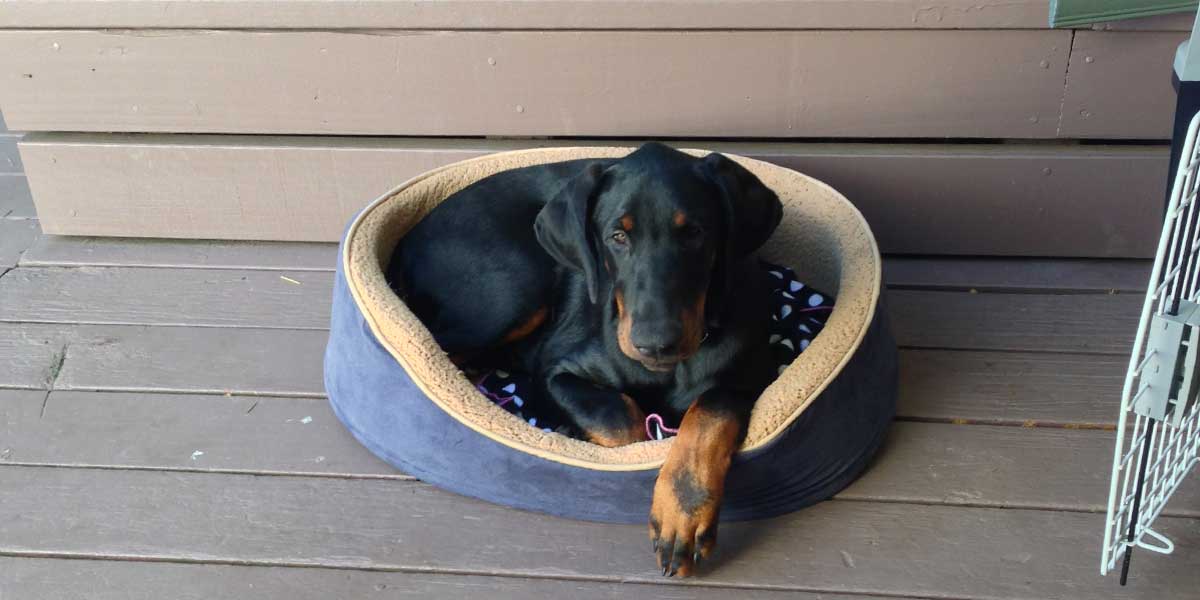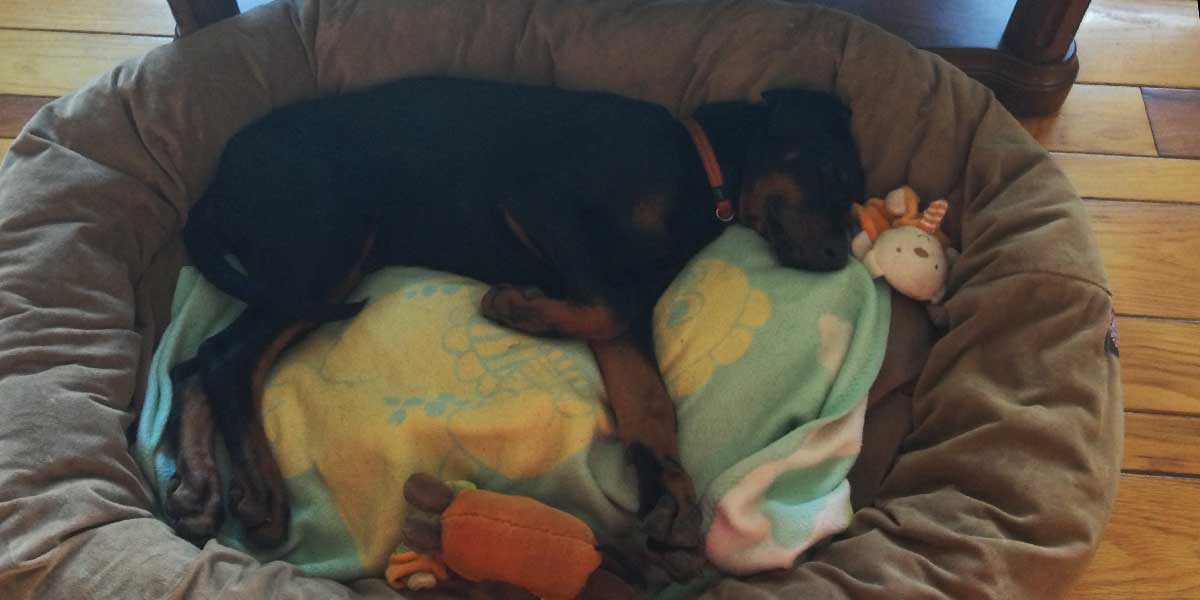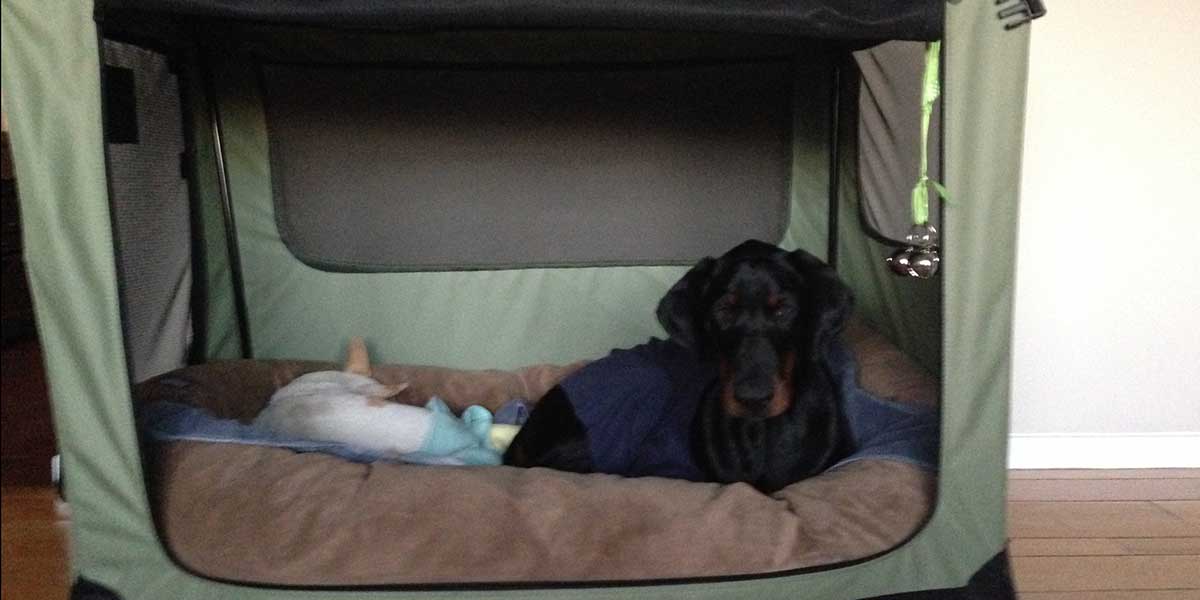
I receive a lot of questions specifically about the first days after the puppy arrives at your home. The first days at home are the most exciting and difficult at the same time. You are excited to finally cuddle and play with your new puppy. For the puppy it is exciting because everything is new. It is difficult for puppy because he/she is lonely, the littermates, mommy, and familiar environment are gone. It is difficult for you because puppy is demanding, won’t sleep in his crate, and often is very vocal.
Many people know to keep the puppy in the crate at night and don’t give in when he is crying. Others – let the puppy sleep in their beds to avoid stressing the puppy and get a chance to sleep at night. Plus, who wouldn’t want to cuddle with a cute puppy? In reality both of the approaches only make the situation more difficult.
Below I describe how I raise my European Doberman puppies and what I do in the first few days to minimize the stress and to start building the relationship.
If your puppy didn’t arrive in a crate, then get one. The crate will be his safe house for at least a couple of months. Keep in mind – I don’t crate my dogs after they are potty trained and learn to respect my home (usually first couple of months). If you plan on keeping your dog crated when he/she is fully grown – get a larger crate that would last you a lifetime.
Find a place for the crate in your house. Ideally, it should be in the area, where you spend the most of your time in general, or (if you not home during the day) – where you spend your evenings. I place the crate in the hallway by the living room. So that when the puppy is in the crate – he can see me when I’m in the living room or dining room.
I prefer to keep the crate in the same location until the dog learns the command and learns his place. When I eventually remove the crate, the dog’s bed remains in the same place. That way – the puppy learns the place and the bed. With time, the puppy learns the command “go to bed” and knows where it is. And after a while – I can move the bed anywhere and the dog will known to associate the command “go to bed” with the bed.
I do not recommend placing the crate in your bedroom or kitchen. Bedroom is your territory and it’s good to teach the puppy to respect your territory. My personal preference – I don’t want dog hair on my clean clothes, and it wakes me up when my dog snores or licks himself at night. And he farts occasionally, too.
Kitchen is not a good place for a crate for a number of reasons. You want to keep your puppy as far as possible from your own food (counter tops and the fridge) and trash bin. Once they discover where the food is coming from – it is a battle to change their mind. I don’t want to have a conflict with my young dog for opening the fridge or going through the trash. And if you follow Doberman groups on Facebook – you see how often this becomes a serious on-going issue.
While the puppy is young it is easier to establish boundaries. Trust me – you will need boundaries when the dog is older. The dog will be your shadow. Read my article A day in the life with a European Doberman for more information. Remember – it is always easier to lift the rules, rather than change or reinforce them.

After you find a good placement for the crate – buy a comfy bed. I prefer bolstered beds – I find it comforting to the puppy: he can snuggle in it and feel warm.
You will need to leave a chew toy inside the crate. Something that is not easily destroyed (and swallowed) at night. I use rope toys or soft chew toys. The toy will keep your puppy occupied if he wakes up in the middle of the night. This toy is not for playing or using outside the crate during the first few weeks. The idea is to associate this toy with a quiet time. Time, where your puppy has to stay alone. Eventually, I use this toy as a clue to modify certain behavior when I’m teaching good manners to my European Doberman puppy.
If you feed kibble to your dog – make sure you left water inside the crate at night. I’ve seen so many articles and breeder recommendations NOT to leave water in the crate in order to avoid the need to go potty in the middle of the night. This is merely to care for pet owners, but to destroy dog’s kidneys. Kibble is a dry food that requires water. If you limit water – your puppy becomes dehydrated and his urine – very concentrated. It is not right to do this to your dog. If you feed raw diet – you puppy won’t drink much water, so no need for a water bowl inside the crate.
It usually takes me about 2-3 days to get a puppy to the point he is comfortable in my home, he knows who takes care of him, and to build initial trust. After 2-3 days (nights) the puppy is no longer crying for his littermates and we all can sleep well at night. It would be best if you can plan to spend 3 full days with a puppy after he/she arrives.
During the day the routine is simple. As soon as puppy wakes up – I carry him outside to potty. This helps me start potty training and also teaches him not to pee in the crate. After that we either play or I feed him. If I fed him – I take him potty again. I carry him outside immediately after he finished eating. Doesn’t matter if he was just outside 15 minutes ago. Woke up – go to the bathroom, ate – go to the bathroom. Make this a routine. It will help with potty training later.
The rest of the time I play with the puppy, let him follow me in the house and watch me do my things. Variety of toys help a lot. If he gets bored with one – he has another one. If he doesn’t have another toy – your shoes, furniture, clothing will become his toys. Bad habit. Buy a variety of toys in advance.
Make a habit of putting your puppy in the crate after he had eventful time. Not after you got tired of him or need to run chores. The sooner your puppy learns that he goes to crate when he is tired and that the crate is a place to sleep – the sooner you get peace at home.
In the evening I make a special effort to entertain my puppy and to make him tired. I would actively play with him, throw toys, make him chase me. Till about 10 pm. It can make him thirsty, so I let him drink water as much as he needs. We tone down our activity for the following hour. I walk him on leash, or let him play by himself. I can do some chores in the house and let him follow me. This routine is active, but no longer exciting for the puppy.
At about 11 pm I take him out to potty. I usually do so on the leash. When the business is taken care of – I walk him to the crate, take the leash and collar off. There is a small piece of treat already waiting for him on the bed. I show him his toy and say “good night”. I usually wave my hand as if I’m saying “bye-bye”. Close the crate, switch off the lights, go to bed.

For the first two nights I sleep on the air mattress next to the crate. This way – puppy doesn’t feel alone. But at the same time – I’m not giving him bad habits by bringing him to my bed every time he whines. Often times – I have the crate door opened and my hand is on the puppy, but it depends on the dog. I had some puppies that would start playing with my hand or some that didn’t like being touched when they sleep.
If puppy wakes up in the middle of the night – I’m right there. He can see me and I talk to him in a quiet voice. This helps build trust and gives comfort to the puppy. He learns he is no longer alone. If I see him being uncomfortable – I will take him out to potty. The same way I did during the day – with the collar and leash on, carry him to the same spot outdoor.
The first few days when I get the puppy – I make sure I’m constantly with him. When I’m feeding him – I sit next to him. When he is playing – I play with him. And when he is asleep – I’m right there next to him.
Many of you, probably will have your puppy shipped one way or another. European dobermans have amazing temperament. When puppy arrives – you won’t even notice he had a stressful time on the airplane. But don’t forget what it meant to him. He lived with his brothers and sisters, with his mother and the breeder taking care of him every time he whines. And then all of a sudden – he is all alone and no one comes when he is crying. So, I believe the bond you build when the puppy arrives is critical. He learns that you are the person he can trust.
After a couple of nights – I move back to sleep in my bedroom and puppy remains in the crate in the living room. I leave my t-shirt (worn, with my scent) inside the crate. I make sure I follow the routine exactly the same way as I did the night before: leash and collar off, treat on his bed, show him the toy, say “good night’, wave the hand, close the crate, switch off the lights, go to bed. He might wake up and whine a bit in the middle of the night, checking where I am. I talk to him from the distance, but don’t come up. Unless I hear he is uncomfortable and might need to go potty. Creating a routine and sticking to it helps a lot in this transition and in potty training.


